
Home - Search - Browse - Alphabetic Index: 0- 1- 2- 3- 4- 5- 6- 7- 8- 9
A- B- C- D- E- F- G- H- I- J- K- L- M- N- O- P- Q- R- S- T- U- V- W- X- Y- Z
Apollo 9
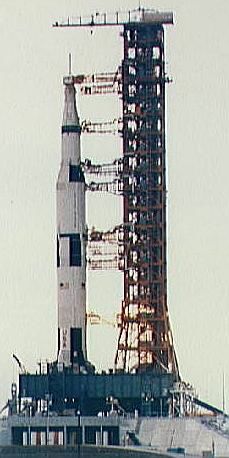 Saturn V Credit: NASA |
AKA: Gumdrop/Spider. Launched: 1969-03-03. Returned: 1969-03-13. Number crew: 3 . Duration: 10.04 days. Location: Michigan Space Center, Jackson, MI.
Apollo 9 (AS-504), the first manned flight with the lunar module (LM-3), was launched from Pad A, Launch Complex 39, KSC, on a Saturn V launch vehicle at 11:00 a.m. EST March 3. Originally scheduled for a February 28 liftoff, the launch had been delayed to allow crew members James A. McDivitt, David R. Scott, and Russell L. Schweickart to recover from a mild virus respiratory illness. Following a normal launch phase, the S-IVB stage inserted the spacecraft into an orbit of 192.3 by 189.3 kilometers. After post-insertion checkout, CSM 104 separated from the S-IVB, was transposed, and docked with the LM. At 3:08 p.m. EST, the docked spacecraft were separated from the S-IVB, which was then placed on an earth-escape trajectory.
On March 4 the crew tracked landmarks, conducted pitch and roll yaw maneuvers, and increased the apogee by service propulsion system burns.
On March 5 McDivitt and Schweickart entered the LM through the docking tunnel, evaluated the LM systems, transmitted the first of two series of telecasts, and fired the LM descent propulsion system. They then returned to the CM.
McDivitt and Schweickart reentered the LM on March 6. After transmitting a second telecast, Schweickart performed a 37-minute extravehicular activity (EVA), walking between the LM and CSM hatches, maneuvering on handrails, taking photographs, and describing rain squalls over KSC.
On March 7, with McDivitt and Schweickart once more in the LM, Scott separated the CSM from the LM and fired the reaction control system thrusters to obtain a distance of 5.5 kilometers between the two spacecraft. McDivitt and Schweickart then performed a lunar-module active rendezvous. The LM successfully docked with the CSM after being up to 183.5 kilometers away from it during the six-and-one-half-hour separation. After McDivitt and Schweickart returned to the CSM, the LM ascent stage was jettisoned.
During the remainder of the mission, the crew tracked Pegasus III, NASA's meteoroid detection satellite that had been launched July 30, 1965; took multispectral photos of the earth; exercised the spacecraft systems; and prepared for reentry.
The Apollo 9 CM splashed down in the Atlantic 290 kilometers east of the Bahamas at 12:01 p.m. EST. The crew was picked up by helicopter and flown to the recovery ship U.S.S. Guadalcanal within one hour after splashdown. Primary objectives of the flight were successfully accomplished.
Official NASA Account of the Mission from Chariots for Apollo: A History of Manned Lunar Spacecraft, by Courtney G Brooks, James M. Grimwood, Loyd S. Swenson, published as NASA SP-4205 in the NASA History Series, 1979.
For the 19th flight of American astronauts into space, Vice President Spiro T. Agnew, representing the new administration of Richard Nixon, sat in the firing control room viewing area on 3 March 1969. He and other guests listened to the countdown of the tall Saturn-Apollo structure several kilometers away at the edge of the Florida beach. Fully recovered from their stuffy heads and runny noses, McDivitt, Scott, and Schweickart lay in the mixed-atmosphere cabin of CSM-104. Breathing pure oxygen through the suit system, they tried to adjust an inlet valve that seemed to have two temperature ranges - too hot and too cold. That was their only problem. Less than one second after its scheduled 11:00 a.m. EST liftoff time, Apollo 9 rumbled upward.
In Houston, where more than 200 newsmen had registered to cover the mission, Flight Director Eugene F. Kranz and Mission Director George H. Hage watched the displays on their consoles while McDivitt and CapCom Stuart Roosa called off the events of the launch sequence. There were the usual vibrations but, on the whole, the Saturn V's S-IC stage gave the crew what McDivitt called "an old lady's ride" - very smooth. The big surprise came when its five engines stopped thrusting. Feeling as if they were being shoved back to the earth, the astronauts lurched forward, almost into the instrument panel. The S-II second stage engines then cut in and pressed them back into the couches. Everything went well until the seven-minute mark, when the old pogo problem popped up again. Although the oscillations were greater than those of Borman's flight, McDivitt's crew lodged no complaints. At 11 minutes 13 seconds from launch, the S-IVB third stage kicked itself and the two spacecraft into orbit 190 kilometers above the earth.
Upon reaching the orbital station, the trio remembered Borman's warning against jumping out of the couches too quickly and flitting about in the weightless cabin. The men avoided sudden head turns, made slow deliberate movements, took medication - and still felt dizzy. But they were able to go about their duties, checking instruments and extending the docking probe. After more than a circuit, 2 hours 43 minutes into the mission, Scott lit the pyrotechnics that separated the command and service modules from the S-IVB stage and began one of the critical steps in the lunar-orbit concept. He fired the thrusters and pulled the command ship away, turned the ship around, fired again, and drew near what he called the "big fellow." Then he noticed that the command module's nose was out of line with the lander's nose. Scott tried to use a service module thruster to turn left, but that jet was not operating. The crew then flipped some switches, which started the thruster working, and at 3 hours 2 minutes the command module probe nestled into the lunar module drogue, where it was captured and held by the latches.
After docking, McDivitt and Schweickart began preparing for their eventual entry into the lunar module. First, they opened a valve to pressurize the tunnel between the two spacecraft. With Scott reading the checklist aloud, McDivitt and Schweickart removed the command module hatch and checked the 12 latches on the docking ring to verify the seal. Next they connected the electrical umbilical lines that would provide command module power to the lander while the vehicles were docked. McDivitt checked the drogue carefully and found no large scars. Meanwhile, Schweickart glanced out the spacecraft window and failed to see the lunar module in the darkness, which scared him. "Oh, my God!" he exclaimed, "I just looked out the window and the LM wasn't there." Scott laughed and said it would be "pretty hard [not to] have a LM out there . . . with Jim in the tunnel." McDivitt put the hatch back in place until time to transfer into the lander. About an hour later, an ejection mechanism kicked the docked spacecraft away from the S-IVB. Apollo 9 backed away, and the Saturn third stage, after firing twice, headed for solar orbit.
McDivitt's crew then turned to another trailblazing task - firing the service module propulsion system. Astronauts had in the past used one vehicle to push another into higher orbit, but never a craft as big as the lander. Some six hours into the mission, they made the first test burn, which lasted five seconds. Flight controllers in Houston considered this the most critical of the docked service module engine firings. Scott must have agreed with them, because he exclaimed, "The LM is still there, by God!" The engine had come on abruptly, McDivitt later said; with the tremendous mass, however, acceleration was very slow - it took the whole 5 seconds to add 11 meters per second to the speed. Sixteen hours after this short burst, a second propulsion system ignition, lasting 110 seconds, included gimbaling (or swiveling) the engine to find out whether the guidance and navigation system's autopilot could steady the spacecraft. The autopilot stilled the motions within 5 seconds.
The crewmen grew more and more confident that they could handle their machines. And that was a good thing, since they next had to make a 280-second burn, to produce an added velocity of 783 meters per second. This lightened the service module's fuel load by 8,462 kilograms and made it easier to turn the vehicles with the reaction control jets. The firing also altered the flight path and raised the apogee of the orbit from 357 to 509 kilometers, to provide better ground tracking and lighting conditions during the rendezvous. Scott later reported that they had the sensation that the docked vehicles were bending slightly in the tunnel area, but the maneuver produced oscillations only one-third to one-half as large as they had expected from training. As the big engine fired, McDivitt commented, "SPS . . . is no sweat." The astronauts were growing so used to the propulsion system that they hardly mentioned its fourth burn. Perhaps they were thinking of their next trailblazing chore, when two of them would crawl into the lunar module and check out its systems.
After they woke in the morning and ate breakfast, McDivitt and Schweickart put on their pressure suits. Schweickart suddenly vomited. Fortunately, he kept his mouth shut until he could reach a bag. Although he did not feel particularly nauseated, both he and McDivitt became slightly disoriented when getting into their suits. For a few seconds, they could not tell up from down, which gave them a queasy feeling. Scott, already dressed, removed the command module hatch, the probe, and the drogue from the tunnel so his colleagues could get into the lunar module. Schweickart slid easily through the 81-centimeter tunnel, opened the lunar module hatch, and went next door in the first intervehicular transfer in space. After he had flipped all the necessary switches, Schweickart reported that the lander was certainly noisy, especially its environmental control system.
McDivitt followed Schweickart into the lunar module an hour later. Within a brief time, a television camera had been unstowed and their activities were being beamed to the earth. Then they shut themselves off from Scott by closing their hatch while he was sealing himself off from Spider. A key event in lunar missions would be the deployment of the landing gear. A second or two after Schweickart pushed the button, the lunar module's legs sprang smartly into place. After the vehicles separated, the lunar module would flip over so the command module pilot could make sure all four legs were in the proper position.
Then Schweickart was sick again, and McDivitt asked for a private talk with the medical people. Although the news media were quickly informed of Schweickart's problem, this request for a "private" discussion was like waving a red flag, causing repercussions and a spate of unfriendly stories. On this second occasion, the impulse to vomit came on just as suddenly as as it had earlier, while Schweickart was busy flipping switches. Afterward, he felt much better and moved around the cabin normally, but he had lost his appetite for anything except liquids and fruits for the remainder of the voyage.
As soon as he was sure the systems were operating properly, McDivitt asked Scott to put the command module into neutral control, so he could check out the lunar module's steering system. McDivitt then operated the small thrusters to get the docked vehicles into the correct position for firing the lunar module's throttleable descent propulsion system. Seconds after starting the large descent engine, McDivitt shouted, "Look at that [attitude] ball; my God, we hardly have any errors." Twenty-six seconds later, at full thrust, he reported that errors were still practically nonexistent. In fact, things were going so smoothly that halfway through the 371.5-second exercise, the commander felt hungry - not an uncommon sensation with him. So he ate before crawling back into the command module. Schweickart stayed behind to shut everything down and straighten up the cabin before joining the others in Gumdrop. The lander appeared to be a dependable machine.
After Schweickart had vomited on two occasions, McDivitt was doubtful that the lunar module pilot would be able to handle his chores outside the spacecraft. The commander recommended to flight control that this exercise be limited to cabin depressurization. Flight control agreed that the extravehicular activity would consist of one daylight period, with Schweickart wearing the portable life support system and the lunar module umbilical hoses, and with both the lunar module and command module hatches open. On the fourth day of flight, working his way into the lander to get it ready, Schweickart felt livelier than he had expected. By the time he had put on the backpack, McDivitt was ready to let him do more - to stand on the porch at least. Flight control told the commander to use his own judgment. So McDivitt fastened Schweickart to the nylon-cord tether that would keep him from floating away from the spacecraft.
Once Schweickart had entered this "third spacecraft," to become essentially a self-contained unit, flight control ran a communications check with PLSS, as they first called him. The four-way conversation - between Spider, Gumdrop, PLSS, and the Houston control center - was much clearer than they had expected. Lunar module depressurization also went smoothly. Schweickart could tell that his backpack was operating, since he could hear water gurgling while he watched his pressure indicator. He was quite comfortable. McDivitt had to use more force than he had anticipated to turn the hatch latch handle and more strength to swing the hatch inside. He was very careful to keep the door pushed back, fearing it might stick closed, leaving Schweickart outside.
Once the lunar module hatch was opened, Scott pushed the command module hatch outward. Schweickart, who now called himself Red Rover because of his rust-colored hair, enjoyed the view and did so well outside on the platform in the golden slippers that McDivitt decided to let him try out the handrails. Hanging on with one hand as he moved about, he took photographs and found that the handholds made everything easier than it had been in simulation, even in underwater training. He did not go over and visit Scott in the command module, but both pilots retrieved experiment samples from the spacecraft hulls. Scott and Schweickart also took pictures of each other, like tourists in a strange country. Originally scheduled to last more than two hours, the extravehicular period ended in less than one, partly because they did not want to tire Schweickart after his illness and partly because they had plenty to do to get ready for the next day's pathfinding activity, the key event of the entire mission: the separation and rendezvous of the lunar module and the command module. With the door closed and their life-sustaining outside equipment off, McDivitt and Schweickart recharged the backpack, tidied up the cabin, and returned to the command module.
On both occasions when they had transferred to the lander, the pilots had been behind the schedule. On 7 March, they got up an hour earlier than usual. They also obtained permission from flight control to move into the lunar module without helmets and oxygen hoses, which made it easier to go through the checklist and to set up the module for the coming maneuvers. Soon both spacecraft were ready. When Scott tried to release the lunar module, however, it hung on the capture latches. He punched the button again and the lander dropped away. McDivitt watched the widening distance between the two craft. Spider then made a 90-degree pitch and a 360-degree yaw maneuver, so Scott could see its legs.
After drifting around within 4 kilometers of the command module for 45 minutes, McDivitt fired the lunar module's descent propulsion engine to increase the distance to nearly 23 kilometers. The motor was smooth until it achieved 10-percent thrust. When McDivitt advanced the throttle to 20 percent, the engine chugged noisily. McDivitt stopped throttling and waited. Within seconds, the chugging stopped. He accelerated to 40 percent before shutting down and had no more problems. McDivitt and Schweickart checked the systems and fired the descent engine again, to a 10-percent throttle setting; this time it ran evenly. As they moved off in a nearly circular orbit 23 kilometers above the command module, they had no trouble seeing Gumdrop, even after the distance stretched to 90 kilometers. From the command module, Scott could spot the lander as far away as 160 kilometers with the help of a sextant. Estimating distances was difficult, but the radar furnished accurate figures.
This new orbit, higher than that of the command ship, created the paradox associated with orbital mechanics of speeding up to go slow. Being higher above the earth (i.e., farther out from it) than the command module, the lander took longer to circle the globe. Spider gradually moved away, trailing 185 kilometers behind Gumdrop. To begin the rendezvous, McDivitt and Schweickart flipped their craft over and fired the thrusters against the flight path to slow their speed enough to drop below the command module's orbital path. Below and behind the command module, they would begin to catch up. They fired the pyrotechnics to dump the descent stage and leave it behind. The firing produced a cloud of debris and caused their blinking tracking light to fail. McDivitt commented that staging was "sort of a kick in the fanny . . . but it went all right." The distance between the lander and the command module soon shortened to 124 kilometers. McDivitt blipped the ascent engine for three seconds to circularize their orbit and begin a chase that would last for more than two hours. As the gap between the two craft narrowed, McDivitt spotted a very small Gumdrop at 75 kilometers.
About an hour after the ascent engine firing, McDivitt and Schweickart lit off their spacecraft's thrusters. "It looks like the Fourth of July," McDivitt commented, and Scott responded that he could see them very clearly. When the thrusters stopped, however, Spider, without its tracking light, was hard for Scott to spot. At that point, remembering the problem they had breaking away, McDivitt told Scott to make sure the command module was ready for docking. As he approached the other craft, the commander turned his machine in all directions so Scott could inspect its exterior. More than six hours after leaving the command module, McDivitt settled the lander firmly back into place and then reported, "I have capture." The 12 latches on the docking ring caught the lunar module and held it fast. Another stretch of the trail to the moon had been blazed. The lunar module could leave the command module, find its way back to it, and dock safely.
Even before crawling back into the command module, McDivitt said he was tired and ready for a three-day holiday. Another 140 hours would pass before touchdown in the Atlantic, but the crew had achieved more than 90 percent of the mission objectives. There were still things to do, such as making more service module engine burns (a total of eight throughout the flight) and jettisoning the ascent stage. Ground control radioed a firing signal to park the lunar module in a 6,965- by 235-kilometer orbit. The crew watched the departing craft a while and then settled down to the more mundane tasks of checking systems, conducting navigation sightings, and taking pictures.
After 151 revolutions in 10 days, 1 hour, and 1 minute, Apollo 9 splashed safely down in the Atlantic, northeast of Puerto Rico, on 13 March 1969, completing a 6-million-kilometer flight that had cost an estimated $340 million. Less than an hour later, the crew was deposited, by helicopter, aboard the carrier U.S.S. Guadalcanal. Then the debriefings and celebrations began. At a ceremony in Washington, with an address by Vice President Agnew, lunar module development leaders Carroll Bolender of the Manned Spacecraft Center and Llewellyn Evans of Grumman were given the NASA Exceptional Service Medal and NASA Public Service Award, respectively. NASA officials were stimulated by the path-breaking voyage of Apollo 9. They were now ready for the final rehearsal, a mission that would take Apollo back to the vicinity of the moon.
More at: Apollo 9.
Family: Manned spaceflight. People: McDivitt, Schweickart, Scott. Country: USA. Spacecraft: Apollo CSM. Projects: Apollo. Launch Sites: Cape Canaveral. Agency: NASA Houston.
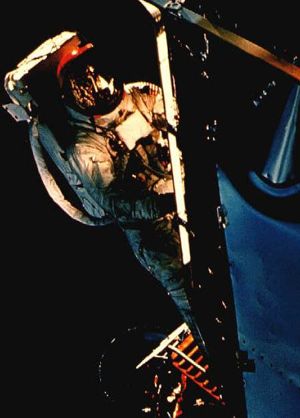 | Apollo 9 On the porch of the LM Credit: NASA |
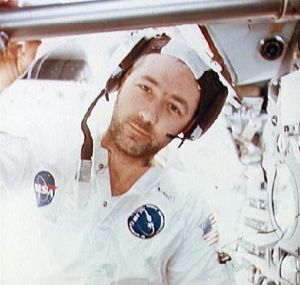 | Apollo 9 Astronaut James McDivitt photographed inside Command Module during EVA Credit: NASA |
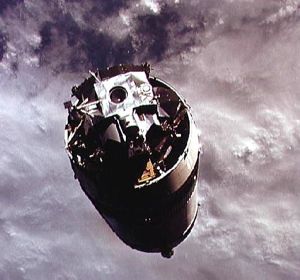 | Apollo 9 Lunar Module 3 attached to Saturn V third stage Credit: NASA |
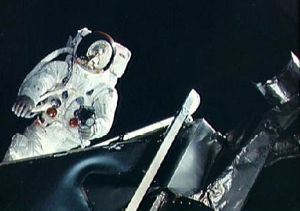 | Apollo 9 Astronaut Russell Schweickart photographed during EVA Credit: NASA |
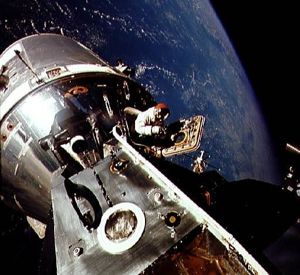 | Apollo 9 View of docked Apollo 9 Command/Service Module and Lunar Module Credit: NASA |
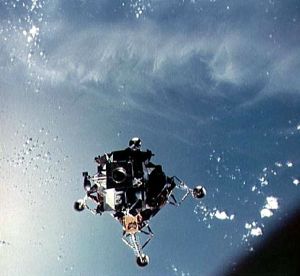 | Apollo 9 Apollo 9 Lunar Module in lunar landing configuration Credit: NASA |
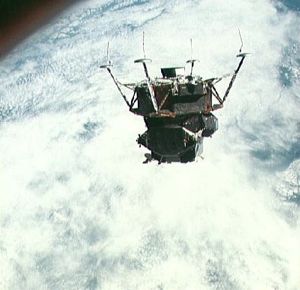 | Apollo 9 Apollo 9 Lunar Module in lunar landing configuration Credit: NASA |
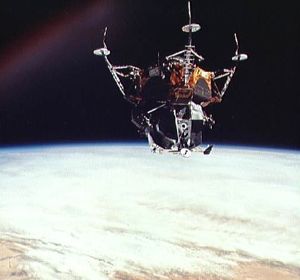 | Apollo 9 Apollo 9 Lunar Module in lunar landing configuration Credit: NASA |
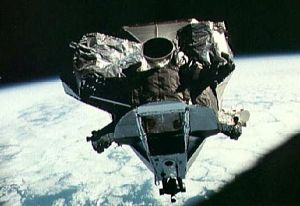 | Apollo 9 Lunar Module ascent stage photographed from Command/Service Module Credit: NASA |
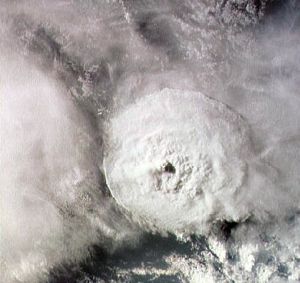 | Apollo 9 Near vertical view of thunderhead over South America as seen from Apollo 9 Credit: NASA |
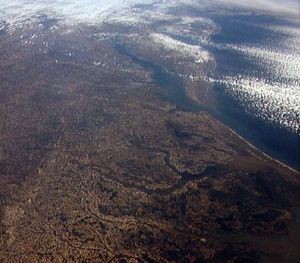 | Apollo 9 North Carolina, Virginia, New Jersey, and New York area as seen from Apollo 9 Credit: NASA |
1965 August - .
- Radiation levels predicted for Apollo LEM-3 crew - .
Nation: USA.
Program: Apollo.
Flight: Apollo 9.
Spacecraft: Apollo LM,
LM Crew Station.
Grumman completed an analysis of radiation levels that would be encountered by the LEM-3 crew during their earth orbital mission. Grumman advised that doses would not be harmful. To lessen these levels even further, the contractor recommended that during some parts of the mission the two astronauts climb back into the CM; also, the planned orbit for the LEM (556 by 2,500 km (300 by 1,350 nm)) could be changed to avoid the worst part of the Van Allen Belt.
1965 December 17 - . Launch Vehicle: Saturn V.
- Proposal rejected that the Development Flight Instrumentation (DFI) on Apollo LEM-3 be deleted - .
Nation: USA.
Program: Apollo.
Flight: Apollo 8,
Apollo 9.
Spacecraft: Apollo LM,
LM Weight.
The MSC Systems Development Branch rejected a proposal that the Development Flight Instrumentation (DFI) on LEM-3 be deleted for the following reasons:
- LEM-3 would be the first full-weight LEM launched on a Saturn V vehicle. . Additional Details: here....
1966 July 20 - .
- Apollo mapping and survey system (M&SS) - . Nation: USA. Related Persons: Gilruth, von Braun. Program: Apollo. Flight: Apollo 9. Spacecraft: Apollo LMSS, CSM Recovery. MSC Director Robert R. Gilruth informed MSFC Director Wernher von Braun that for the past two years MSC had studied the use of the mapping and survey system (M&SS) in conjunction with the Apollo program.. Additional Details: here....
1966 November 9 - .
- Feasibility and cost tradeoffs of real-time television coverage of Apollo missions - . Nation: USA. Program: Apollo. Flight: Apollo 9. NASA Associate Administrator for Manned Space Flight George E. Mueller reported on technical feasibility and cost tradeoffs of real-time television coverage of Apollo missions. . Additional Details: here....
1967 October 13 - .
- Apollo Spacecraft Configuration Control Board reins in changes - . Nation: USA. Related Persons: Faget. Program: Apollo. Flight: Apollo 9. Spacecraft: Apollo LM. In an effort to keep a tight rein on changes made in spacecraft, the Apollo Spacecraft Configuration Control Board (CCB) established ground rules.. Additional Details: here....
1967 October 28 - .
- Ground rules for Apollo extravehicular activity - .
Nation: USA.
Program: Apollo.
Flight: Apollo 8,
Apollo 9.
The following ground rules were established for extravehicular activity planning. The EVA transfer would be demonstrated and thermal-degradation samples retrieved during the AS-503/103/LM-3 (Apollo 8) mission. No other pre-lunar-landing mission would include planned EVA exercises. The first lunar landing mission would be planned with two EVA excursions.
1967 October 30 - .
- Actions on Apollo television cameras reported - . Nation: USA. Program: Apollo. Flight: Apollo 9. Spacecraft: Apollo LM, LM Weight. Actions on television cameras were reported by ASPO Manager George M. Low to Apollo Program Director Samuel C. Phillips. . Additional Details: here....
1967 December 9 - .
- Competing Apollo LM ascent engine qualification dates provided - .
Nation: USA.
Program: Apollo.
Flight: Apollo 9.
Spacecraft: Apollo LM,
LM Ascent Propulsion.
MSC ASPO Manager George M. Low reminded NASA Apollo Program Director Samuel C. Phillips that at a meeting three weeks previous MSC had presented a Bell Aerospace Corp. qualification completion date for the LM ascent engine of March 28, and a Rocketdyne Division, North American Rockwell, completion by May 1, 1968. Additional Details: here....
1968 January 5 - .
- Review of the LM ascent engine backup program - . Nation: USA. Related Persons: Rees. Program: Apollo. Flight: Apollo 9. Spacecraft: Apollo LM, LM Ascent Propulsion. Apollo Special Task Team (ASTT) Director Eberhard F. M. Rees, Martin L. Raines, and Ralph Taeuber of MSC, and J. McNamara, North American Rockwell, visited Rocketdyne Division to review the status of the LM ascent engine backup program. . Additional Details: here....
1968 January 11 - .
- Concern over configuration control of Apollo flight hardware - . Nation: USA. Program: Apollo. Flight: Apollo 9. Spacecraft: Apollo CSM, CSM Block II. CSM Manager Kenneth S. Kleinknecht wrote his counterpart at North American Rockwell, Dale D. Myers, to express concern about NR's seeming inability to implement configuration control of flight hardware and ground support equipment. . Additional Details: here....
1968 February 26 - .
- Stress corrosion and window problems in the Apollo LM resolved - . Nation: USA. Program: Apollo. Flight: Apollo 9. Spacecraft: Apollo LM, LM Structural. Stress corrosion and window problems in the LM had been resolved, NASA Associate Administrator for Manned Space Flight George E. Mueller advised the Administrator in his weekly progress report. . Additional Details: here....
1968 March 6-7 - .
- Design Certification Reviews of Apollo Apollo CSM 101 and LM-3 - .
Nation: USA.
Program: Apollo.
Flight: Apollo 9.
Spacecraft: Apollo LM,
CSM Block II,
CSM SPS.
Design Certification Reviews of CSM 101 and LM-3 were held at MSC. Significant program-level agreements reached included validation of a 60-percent-oxygen and 40-percent-nitrogen cabin atmosphere during launch; reaffirmation of the February 6 Management Council decision that a second unmanned LM flight was not required; and the conclusion that, in light of successful static firing of the 102 service propulsion system and subsequent analysis, a static-firing of the 101 system was not required.
1968 March 19 - .
- Suggestion of added Apollo spacecraft delivery delays rejected - . Nation: USA. Program: Apollo. Flight: Apollo 9. Spacecraft: Apollo CSM, CSM Block II. ASPO Manager George Low emphatically rejected North American Rockwell's suggestion of added spacecraft delivery delays. . Additional Details: here....
1968 April 27 - .
- Delays in Apollo CSM and LM delivery dates - .
Nation: USA.
Related Persons: Low, George.
Program: Apollo.
Flight: Apollo 9.
Spacecraft: Apollo CSM,
CSM Block II.
ASPO Manager George M. Low explained to the Apollo Program Director the underlying causes of slips in CSM and LM delivery dates since establishment of contract dates during the fall of 1967. The general excuse, Low said, was that slips were the result of NASA-directed hardware changes. "This excuse is not valid." He recounted how NASA-imposed changes had been under strict control and only essential changes had been approved by the MSC Level II Configuration Control Board (CCB). Additional Details: here....
1968 May 28 - .
- Apollo LM ascent engine problem resolved - . Nation: USA. Program: Apollo. Flight: Apollo 9. Spacecraft: Apollo LM, LM Ascent Propulsion. NASA and Grumman officials met to resolve the issue of the injector for the LM ascent engine.. Additional Details: here....
1968 June 3 - .
- Test to detect toxic hazards inside Apollo spacecraft - .
Nation: USA.
Program: Apollo.
Flight: Apollo 9.
Spacecraft: Apollo LM,
CSM Block II,
LM Crew Station.
ASPO Manager George Low advised Apollo program officials at KSC that, to collect adequate data for evaluating any potential toxicological hazard inside the spacecraft, collection of gas samples of the cabin atmosphere must be made for 12 hours during the unmanned altitude chamber test with all systems operating. Low asked that this requirement be included in the spacecraft test procedures. Additional Details: here....
1968 June 10 - .
- Important Apollo events - . Nation: USA. Program: Apollo. Flight: Apollo 9. Spacecraft: Apollo LM, LM RCS. In his weekly progress report to the NASA Administrator, Deputy Administrator for Manned Space Flight George E. Mueller cited several important Apollo events during the first week of June.. Additional Details: here....
1968 August 7 - . Launch Vehicle: Saturn V.
- George Low promotes idea of flying Apollo 8 as a lunar orbit mission without the Lunar Module - .
Nation: USA.
Related Persons: von Braun.
Program: Apollo.
Flight: Apollo 7,
Apollo 8,
Apollo 9.
Spacecraft: Apollo CSM,
Apollo LM,
CSM Block II,
LM Guidance,
LM RCS.
On August 7, Low asked MSC's Director of Flight Operations Christopher C. Kraft, Jr., to look into the feasibility of a lunar orbit mission for Apollo 8 without carrying the LM. A mission with the LM looked as if it might slip until February or March 1969. The following day Low traveled to KSC for an AS-503 review, and from the work schedule it looked like a January 1969 launch. Additional Details: here....
1968 August 7 - .
- Apollo Review Board certifies the design of Apollo LM-3 - .
Nation: USA.
Program: Apollo.
Flight: Apollo 9.
Spacecraft: Apollo LM.
The Apollo Design Certification Review (DCR) Board convened at MSC to examine LM-3 further for proof of design and development maturity and to assess and certify the design of the LM-3 as flightworthy and safe for manned flight. This Delta review was identified as a requirement at the March 6 LM-3 DCR. The Board concluded at the close of the Delta DCR that LM-3 was safe to fly manned with the completion of open work and action items identified during the review.
1968 August 8 - .
- Test and checkout problems for Apollo AS-503 and AS-504 - .
Nation: USA.
Related Persons: Debus,
Petrone.
Program: Apollo.
Flight: Apollo 8,
Apollo 9.
ASPO Manager George M. Low and several members of his staff met at KSC with Center Director Kurt H. Debus, Launch Operations Director Rocco A. Petrone, and KSC Apollo Program Manager R. O. Middleton to discuss test and checkout problems for AS-503 and AS-504. Additional Details: here....
1968 August 9 - . Launch Vehicle: Saturn V.
- Senior Apollo porject management backs Apollo 8 lunar mission concept - . Nation: USA. Related Persons: Low, George, von Braun. Program: Apollo. Flight: Apollo 7, Apollo 8, Apollo 9. Spacecraft: Apollo CSM, Apollo LTA. August 9 was probably one of the busiest days in George Low's life; the activities of that and the following days enabled the United States to meet the "in this decade" goal.. Additional Details: here....
1968 August 13 - . Launch Vehicle: Saturn V.
- Borman crew selected for Apollo 8 lunar mission. - .
Nation: USA.
Related Persons: Borman,
Low, George.
Program: Apollo.
Flight: Apollo 8,
Apollo 9.
Spacecraft: Apollo CSM.
Kleinknecht had concluded his CSM 103-106 configuration study by August 13 and determined the high-gain antenna was the most critical item. Kraft was still "GO" and said December 20-26 (except December 25) offered best launch times; he had also looked at January launch possibilities. Slayton had decided to assign the 104 crew to the mission. He had talked to crew commander Frank Borman and Borman was interested.
1968 August 17 - . Launch Vehicle: Saturn V.
- Webb approves Apollo 8 lunar orbit mission for December - .
Nation: USA.
Related Persons: Low, George,
Webb.
Program: Apollo.
Flight: Apollo 7,
Apollo 8,
Apollo 9.
Spacecraft: Apollo CSM.
Webb approves Apollo 8 lunar orbit mission for December - but no public announcement until after a successful Apollo 7 flight. Phillips and Hage visited MSC, bringing the news that Webb had given clear-cut authority to prepare for a December 6 launch, but that they could not proceed with clearance for lunar orbit until after the Apollo 7 flight, which would be an earth-orbital mission with basic objectives of proving the CSM and Saturn V systems. Phillips said that Webb had been "shocked and fairly negative" when he talked to him about the plan on August 15. Subsequently, Paine and Phillips sent Webb a lengthy discourse on why the mission should be changed, and it was felt he would change his mind with a successful Apollo 7 mission.
1968 September 25 - .
- Concerns over quality coverage of Apollo spacecraft testing - .
Nation: USA.
Program: Apollo.
Flight: Apollo 9.
Spacecraft: Apollo CSM,
CSM Block II.
NASA Resident ASPO Manager Wilbur H. Gray at Downey told Dale D. Myers, North American Rockwell CSM Manager, that NR quality coverage of spacecraft testing no longer provided NASA with confidence in test results and that NASA Quality Control would return to monitoring test activities in and from the ACE (acceptance checkout equipment) control room. Gray charged that North American had progressively backed away from contractually agreed steps of the November 30, 1967, Quality Program Plan, and that these actions had affected test readiness, testing, and trouble shooting to the point that test acceptance could not be accepted with any reasonable assurance. Gray said that - unless North American responded by immediate reinstatement of the procedures which, as a minimum, were those that worked satisfactorily on CSMs 103 and 104 - NASA formal acceptance of operational checkout procedures would be discontinued and contractual action initiated. An annotation to George Low from Kenneth S. Kleinknecht, MSC's CSM Manager, indicated the letter had been written with the concurrence and at the suggestion of Kleinknecht.
Myers replied: "I regret that NASA feels any lack of confidence in current test results. . . . For the past year, there has been a constant improvement program carried out in Test Quality Assurance to (1) perform quality evaluation and acceptance of test results in real time and (2) upgrade the test discipline to be consistent with good quality practice. I believe that this improvement program has been effective and is evidenced by the current efficiency of test and expedient manner in which test paper work is being closed out. While there is naturally some cost benefit experienced from the successful improvements, cost never has been placed as a criteria above quality. . . .
"Again, I want to emphasize that the CSM Program has not nor will not intentionally place cost ahead of quality. . . . The procedures which worked satisfactorily on CSM 103 and 104 are being improved to provide better test discipline and more effective Quality Assurance coverage. Test progress on CSM 106 to date indicates a greater test effectiveness and a greater confidence in test results than any previous CSM's." Additional Details: here....
1968 September 25 - .
- Apollo LM ascent engine to use Rocketdyne injector - . Nation: USA. Program: Apollo. Flight: Apollo 9. Spacecraft: Apollo LM, LM Ascent Propulsion. The LM ascent engine to be flown in LM-3 and subsequent missions would incorporate the Rocketdyne injector, Apollo Program Director Phillips informed ASPO Manager Low. The engine would be assembled and delivered by Rocketdyne under subcontract to Grumman.. Additional Details: here....
1968 October 21 - .
- Launch preparations for Apollo 8 and 9 - . Nation: USA. Program: Apollo. Flight: Apollo 8, Apollo 9. Spacecraft: Apollo LM, CSM Block II. Associate Administrator for Manned Space Flight George E. Mueller summarized launch preparations for the near-term missions Apollo 8 and Apollo 9. . Additional Details: here....
1968 October 31 - .
- AS-504 and AS-505 missions officially designated as Apollo 9 and Apollo 10 - . Nation: USA. Related Persons: Phillips, Samuel. Program: Apollo. Flight: Apollo 10, Apollo 9. NASA Apollo Program Director Samuel C. Phillips officially designated the AS-504 and AS-505 missions as Apollo 9 and Apollo 10..
1968 December 15 - .
- Final countdown for the launch of Apollo 8 - .
Nation: USA.
Program: Apollo.
Flight: Apollo 8,
Apollo 9.
Final countdown for the launch of Apollo 8, the second manned Apollo mission, began on schedule at KSC. Significant launch preparation events included the "wet" countdown demonstration test on December 10, three days of flight simulations, an operational review, and launch site recovery exercises. Mission preparations were on schedule for launch on December 21. Launch preparations were also on schedule for the next two flights, Apollo 9 and 10.
1968 December 16 - .
- Potential uses for television aboard Apollo CSM and LM - . Nation: USA. Program: Apollo. Flight: Apollo 9. Spacecraft: Apollo LM, CSM Block II, LM Television. NASA Apollo Program Director Samuel C. Phillips asked ASPO Manager George M. Low for comments on potential uses for television aboard all Apollo spacecraft (both CMs and LMs). . Additional Details: here....
1968 December 24 - .
- Plans for television cameras aboard remaining Apollo missions - .
Nation: USA.
Related Persons: Low, George.
Program: Apollo.
Flight: Apollo 13,
Apollo 9.
Spacecraft: Apollo LM,
CSM Block II,
LM Television.
ASPO Manager George M. Low apprised Program Director Samuel C. Phillips of MSC's plans for television cameras aboard remaining Apollo missions. With the exception of spacecraft 104 (scheduled for flight as Apollo 9), television cameras were to be flown in all CMs. Also, cameras would be included in all manned LMs (LM-3 through LM-14).
1969 January 3 - .
- Mission preparation for Apollo 9 continued on schedule - .
Nation: USA.
Program: Apollo.
Flight: Apollo 9.
Mission preparation for Apollo 9 continued on schedule. Rollout of the space vehicle from the Vehicle Assembly Building, KSC, began. Mission Control Center simulations checkout, which began at MSC on December 20, 1968, was proceeding on schedule. Also, a series of thermal vacuum tests was completed, with the Apollo 9 crew using extravehicular mobility unit (EMU) flight equipment. Wind up of these tests completed the required EMU testing for the Apollo 9 flight.
1969 January 15-17 - . Launch Vehicle: Saturn V.
- Final flight program for Apollo 9 verified - . Nation: USA. Program: Apollo. Flight: Apollo 9. Spacecraft: Apollo LM, LM Crew Station. The final flight program for Apollo 9 was verified; the emergency egress test with the prime and backup crew was conducted; and the software integration test between the lunar module and Mission Control Center, MSC, was completed on January 15. . Additional Details: here....
1969 January 19-22 - .
- Apollo 9 flight readiness test - .
Nation: USA.
Program: Apollo.
Flight: Apollo 8,
Apollo 9.
The Apollo 9 flight readiness test began on January 19 and was successfully completed January 22, in preparation for a February launch. A one-day delay in the testing was caused by a loss of air conditioning for the RCA-110A computer. The hatch and side windows of the spacecraft were being modified to overcome the fogging effect experienced during the Apollo 8 mission.
1969 January 24-29 - .
- Tests completed for the Apollo 9 launch - .
Nation: USA.
Program: Apollo.
Flight: Apollo 9.
The following tests were completed in preparation for the planned February Apollo 9 launch: all Mission Control Center data system integration tests, MSC preflight readiness test, KSC launch readiness test, and MSFC preflight test. In addition, recovery training exercises were conducted aboard the U.S.S. Guadalcanal, the prime recovery ship for Apollo 9.
1969 January 24 - .
- Apollo CSM Flight Readiness Review Board - .
Nation: USA.
Program: Apollo.
Flight: Apollo 9.
Spacecraft: Apollo CSM,
CSM Block II.
The CSM Flight Readiness Review Board convened at MSC. Martin L. Raines presented the Reliability and Quality Assurance assessment and pointed out the improvement in discrepancy reports between spacecraft 101, 103, and 104 and concluded that 104 was better than 103 and ready to fly. George M. Low noted that the CSM Review had been outstanding.
1969 January 25 - . Launch Vehicle: N1.
- Apollo vs Ye-8-5 - .
Nation: Russia.
Program: Lunar L3,
Luna,
Apollo.
Flight: Apollo 9.
Spacecraft Bus: Luna Ye-8.
Spacecraft: Luna Ye-8-5.
America is preparing Apollo 9 for flight, and Kamanin muses that the Soviet reply will be the N1 and Ye-8-5, neither of which is proven or reliable. The Soviet Union would have a better chance of sending a manned L1 on a flight around the moon during the first quarter of 1969. Meanwhile Mishin's bureau has a new L3M lunar lander on the drawing boards. This will land 4 to 5 men on the moon, but require two N1 or seven UR-500K launches to assemble in orbit.
1969 January 31 - .
- Aluminum fittings replaced in Apollo lunar modules - . Nation: USA. Program: Apollo. Flight: Apollo 10, Apollo 9. Spacecraft: Apollo LM, LM Landing Gear. About 30 small aluminum brackets and fittings were replaced or reinforced in Apollo lunar modules to rule out the possibility of cracking from stress corrosion. . Additional Details: here....
1969 February 3 - .
- 12-month plan for Apollo missions - .
Nation: USA.
Program: Apollo.
Flight: Apollo 10,
Apollo 11,
Apollo 12,
Apollo 13,
Apollo 9.
Spacecraft: Apollo LM,
CSM Recovery.
NASA Hq. released a 12-month forecast of manned space flight missions, reflecting an assessment of launch schedules for planning purposes. Five flights were scheduled for the remainder of 1969:
- Apollo 9 - February 28, SA-504, CSM 104, LM-3; manned orbital; up to 10 days' duration; Atlantic recovery.
- Apollo 10 - May 17, SA-505, CSM 106, LM-4; manned lunar mission, Pacific recovery.
- Apollo 11 - SA-506, CSM 107, LM-5; manned lunar mission; up to 11 days' duration; Pacific recovery.
- Apollo 12 - SA-507, CSM 108, LM-6; manned lunar mission; up to 11 days; Pacific recovery.
- Apollo 13 - SA-508, CSM 109, LM-7; manned lunar mission; up to 11 days' duration; Pacific recovery.
1969 February 22 - .
- Apollo 9 countdown began - .
Nation: USA.
Program: Apollo.
Flight: Apollo 9.
Spacecraft: Apollo LM.
The Apollo 9 countdown to launch began, with launch scheduled for liftoff February 28. The 10-day flight would mark the first manned earth orbital flight of the lunar module, the first Apollo spacewalk, and the first manned checkout, rendezvous, and docking operations of the complete Apollo spacecraft. The Apollo 9 mission would be open-ended, allowing the mission plan to progress from one step to the next on the basis of real-time success.
1969 March 3 - . 16:00 GMT - . Launch Site: Cape Canaveral. Launch Complex: Cape Canaveral LC39A. Launch Platform: LUT2. Launch Vehicle: Saturn V.
- Apollo 9 - .
Call Sign: Gumdrop. Crew: McDivitt,
Schweickart,
Scott.
Backup Crew: Bean,
Conrad,
Gordon.
Payload: Apollo CSM 104 / Apollo LM 3 / Saturn S-IVB-504N. Mass: 36,511 kg (80,492 lb). Nation: USA.
Agency: NASA Houston.
Program: Apollo.
Class: Moon.
Type: Manned lunar spacecraft. Flight: Apollo 9.
Spacecraft: Apollo CSM.
Duration: 10.04 days. Decay Date: 1969-03-13 . USAF Sat Cat: 3769 . COSPAR: 1969-018A. Apogee: 187 km (116 mi). Perigee: 185 km (114 mi). Inclination: 32.60 deg. Period: 88.60 min.
Apollo 9 (AS-504), the first manned flight with the lunar module (LM-3), was launched from Pad A, Launch Complex 39, KSC, on a Saturn V launch vehicle at 11:00 a.m. EST March 3. Originally scheduled for a February 28 liftoff, the launch had been delayed to allow crew members James A. McDivitt, David R. Scott, and Russell L. Schweickart to recover from a mild virus respiratory illness. Following a normal launch phase, the S-IVB stage inserted the spacecraft into an orbit of 192.3 by 189.3 kilometers. After post-insertion checkout, CSM 104 separated from the S-IVB, was transposed, and docked with the LM. At 3:08 p.m. EST, the docked spacecraft were separated from the S-IVB, which was then placed on an earth-escape trajectory. On March 4 the crew tracked landmarks, conducted pitch and roll yaw maneuvers, and increased the apogee by service propulsion system burns.
On March 5 McDivitt and Schweickart entered the LM through the docking tunnel, evaluated the LM systems, transmitted the first of two series of telecasts, and fired the LM descent propulsion system. They then returned to the CM.
McDivitt and Schweickart reentered the LM on March 6. After transmitting a second telecast, Schweickart performed a 37-minute extravehicular activity (EVA), walking between the LM and CSM hatches, maneuvering on handrails, taking photographs, and describing rain squalls over KSC.
On March 7, with McDivitt and Schweickart once more in the LM, Scott separated the CSM from the LM and fired the reaction control system thrusters to obtain a distance of 5.5 kilometers between the two spacecraft. McDivitt and Schweickart then performed a lunar-module active rendezvous. The LM successfully docked with the CSM after being up to 183.5 kilometers away from it during the six-and-one-half-hour separation. After McDivitt and Schweickart returned to the CSM, the LM ascent stage was jettisoned.
During the remainder of the mission, the crew tracked Pegasus III, NASA's meteoroid detection satellite that had been launched July 30, 1965; took multispectral photos of the earth; exercised the spacecraft systems; and prepared for reentry.
- Apollo 9 LM - . Call Sign: Spider. Payload: Apollo LM 3. Mass: 14,530 kg (32,030 lb). Nation: USA. Agency: NASA Houston. Program: Apollo. Class: Moon. Type: Manned lunar spacecraft. Flight: Apollo 9. Spacecraft: Apollo LM. Duration: 10.04 days. Decay Date: 1969-03-13 . USAF Sat Cat: 3769 . COSPAR: 1969-018x. Apogee: 187 km (116 mi). Perigee: 185 km (114 mi). Inclination: 32.60 deg. Period: 88.60 min.
1969 March 6 - . 16:45 GMT - .
- EVA Apollo 9-1 - . Crew: Schweickart, Scott. EVA Duration: 0.0319 days. Nation: USA. Related Persons: Schweickart, Scott. Program: Apollo. Class: Moon. Type: Manned lunar lander. Flight: Apollo 9. Spacecraft: A7L, Apollo LM. Stand-Up External Vehicular Activity. Tested Apollo spacesuit..
1969 March 7 - .
- Accomplishments of the space program summarized - .
Nation: USA.
Program: Apollo.
Flight: Apollo 9.
Spacecraft: Apollo LM,
CSM Recovery,
LM Ascent Propulsion,
LM Descent Propulsion.
In a report to the Administrator, the Associate Administrator for Manned Space Flight summed up the feeling of accomplishment as well as the problem of the space program: "The phenomenal precision and practically flawless performance of the Apollo 9 lunar module descent and ascent engines on March 7 were major milestones in the progress toward our first manned landing on the moon, and tributes to the intensive contractor and government effort that brought these two complex systems to the point of safe and reliable manned space flight. Additional Details: here....
1969 March 10 - . Launch Vehicle: N1.
- Apollo 9 points to US win - . Nation: Russia. Program: Lunar L3. Flight: Apollo 9. Kamanin notes the successful Apollo 9 mission. In his opinion Americans will land on the moon by the end of the year. The Soviet program is 3 to 4 years behind..
1969 March 13 - .
- Landing of Apollo 9 - .
Return Crew: McDivitt,
Schweickart,
Scott.
Nation: USA.
Related Persons: McDivitt,
Schweickart,
Scott.
Program: Apollo.
Flight: Apollo 9.
The Apollo 9 CM splashed down in the Atlantic 290 kilometers east of the Bahamas at 17:01 GMT. The crew was picked up by helicopter and flown to the recovery ship U.S.S. Guadalcanal within one hour after splashdown. Primary objectives of the flight were successfully accomplished.
1969 March 24 - .
- Apollo 10 would be a lunar orbit mission - . Nation: USA. Program: Apollo. Flight: Apollo 10, Apollo 9. Spacecraft: Apollo LM, CSM Recovery. NASA announced that Apollo 10, scheduled for launch May 18, would be a lunar orbit mission during which two astronauts would descend to within 15,240 meters of the moon's surface. . Additional Details: here....
1969 March 28 - . Launch Vehicle: Saturn V.
- Apollo astronauts thrown forward during Saturn V S-IC/S-II stage separation - . Nation: USA. Program: Apollo. Flight: Apollo 9. Following a report by the Apollo 9 astronauts that they were thrown forward in their seats and had to grab their arm rests for support during the S-IC/S-II stage separation, an evaluation working group were studying the problem. . Additional Details: here....
1969 March 29 - .
- Apollo films on view in Soviet Union - . Nation: Russia. Program: Lunar L3. Flight: Apollo 8, Apollo 9. VVS General Staff views US documentaries on Apollo 8 and 9, and footage from the 1968 Turin Air Show..
1969 June 13 - .
- Leonov in trouble - . Nation: Russia. Related Persons: Leonov, Shatalov, Yeliseyev. Program: Lunar L3, Luna. Flight: Apollo 9, Soyuz 4/5. Leonov interviewed by Japanese reporters. He tells them that both manned and unmanned lunar spacecraft are in preparation and that lunar rocks will be returned by Soviet spacecraft by March 1970.. Additional Details: here....
1998 April 5 - .
- From the Earth to the Moon is released. - .
Nation: USA.
Flight: Apollo 11,
Apollo 12,
Apollo 13,
Apollo 14,
Apollo 15,
Apollo 17,
Apollo 7,
Apollo 8,
Apollo 9.
Based on the success of the film Apollo 13, Tom Hanks was able to raise $ 68 million to film a television mini-series covering the entire Apollo program. The Apollo 13 episode marked the third fictionalised telling of the tale, this time concentrating on the media handling of the flight and the changing nature of television news. Additional Details: here....
Back to top of page
Home - Search - Browse - Alphabetic Index: 0- 1- 2- 3- 4- 5- 6- 7- 8- 9
A- B- C- D- E- F- G- H- I- J- K- L- M- N- O- P- Q- R- S- T- U- V- W- X- Y- Z
© 1997-2019 Mark Wade - Contact
© / Conditions for Use